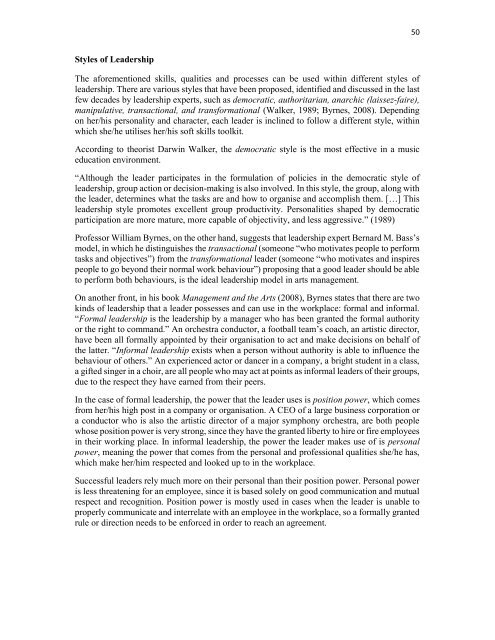and Music
Omega-Book
Omega-Book
You also want an ePaper? Increase the reach of your titles
YUMPU automatically turns print PDFs into web optimized ePapers that Google loves.
50<br />
Styles of Leadership<br />
The aforementioned skills, qualities <strong>and</strong> processes can be used within different styles of<br />
leadership. There are various styles that have been proposed, identified <strong>and</strong> discussed in the last<br />
few decades by leadership experts, such as democratic, authoritarian, anarchic (laissez-faire),<br />
manipulative, transactional, <strong>and</strong> transformational (Walker, 1989; Byrnes, 2008). Depending<br />
on her/his personality <strong>and</strong> character, each leader is inclined to follow a different style, within<br />
which she/he utilises her/his soft skills toolkit.<br />
According to theorist Darwin Walker, the democratic style is the most effective in a music<br />
education environment.<br />
“Although the leader participates in the formulation of policies in the democratic style of<br />
leadership, group action or decision-making is also involved. In this style, the group, along with<br />
the leader, determines what the tasks are <strong>and</strong> how to organise <strong>and</strong> accomplish them. […] This<br />
leadership style promotes excellent group productivity. Personalities shaped by democratic<br />
participation are more mature, more capable of objectivity, <strong>and</strong> less aggressive.” (1989)<br />
Professor William Byrnes, on the other h<strong>and</strong>, suggests that leadership expert Bernard M. Bass’s<br />
model, in which he distinguishes the transactional (someone “who motivates people to perform<br />
tasks <strong>and</strong> objectives”) from the transformational leader (someone “who motivates <strong>and</strong> inspires<br />
people to go beyond their normal work behaviour”) proposing that a good leader should be able<br />
to perform both behaviours, is the ideal leadership model in arts management.<br />
On another front, in his book Management <strong>and</strong> the Arts (2008), Byrnes states that there are two<br />
kinds of leadership that a leader possesses <strong>and</strong> can use in the workplace: formal <strong>and</strong> informal.<br />
“Formal leadership is the leadership by a manager who has been granted the formal authority<br />
or the right to comm<strong>and</strong>.” An orchestra conductor, a football team’s coach, an artistic director,<br />
have been all formally appointed by their organisation to act <strong>and</strong> make decisions on behalf of<br />
the latter. “Informal leadership exists when a person without authority is able to influence the<br />
behaviour of others.” An experienced actor or dancer in a company, a bright student in a class,<br />
a gifted singer in a choir, are all people who may act at points as informal leaders of their groups,<br />
due to the respect they have earned from their peers.<br />
In the case of formal leadership, the power that the leader uses is position power, which comes<br />
from her/his high post in a company or organisation. A CEO of a large business corporation or<br />
a conductor who is also the artistic director of a major symphony orchestra, are both people<br />
whose position power is very strong, since they have the granted liberty to hire or fire employees<br />
in their working place. In informal leadership, the power the leader makes use of is personal<br />
power, meaning the power that comes from the personal <strong>and</strong> professional qualities she/he has,<br />
which make her/him respected <strong>and</strong> looked up to in the workplace.<br />
Successful leaders rely much more on their personal than their position power. Personal power<br />
is less threatening for an employee, since it is based solely on good communication <strong>and</strong> mutual<br />
respect <strong>and</strong> recognition. Position power is mostly used in cases when the leader is unable to<br />
properly communicate <strong>and</strong> interrelate with an employee in the workplace, so a formally granted<br />
rule or direction needs to be enforced in order to reach an agreement.


